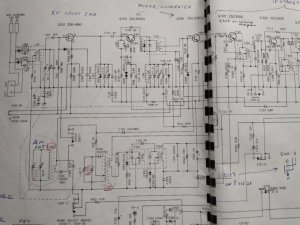The problem with your situation is that I don't trust your readings. You are claiming that the Q104C reads 6.42v while Q104E reads 7.5v with the Q104B only reading 0.11v. If you understand transistors, this scenario isn't really possible with an NPN transistor. The source of the emitter current generally comes from the collector, so the transistor output can't read higher than the source. Then there is only 0.11v at the base. This small base voltage doesn't even overcome the device turn on point of approximately 0.5V to 0.6V (higher) than the emitter. In other words, with the Base voltage at 0.11v, the transistor isn't even turned on, ergo, ZERO amplification and emitter should read or be very close to zero. (Unless) 1: the emitter is reading (negative voltage potential) sufficient to overcome the base turn on voltage, or (2) If your readings are true, then that means that the emitter current comes from elsewhere. However, if you analyze the circuit, you will see that the emitter goes to ground through a resistor, so that path does not provide positive current. When emitter readings are unusually high, the first thing to investigate or suspect is whether that resistor has opened, but even if it has, the emitter should not exceed the collector voltage. The other possible current source path is through a capacitor, which if working properly blocks DC. So no DC current through that path either. Or are you actually measuring AC? The term gobblydegook basically states garbage-in, garbage-out. In other words, without good data, any analysis or result of such analysis would be garbage so if the data is obviously problematic, it often is not worth proceeding further until the source of that erroneous data can be clarified. Are you relying on the board markings to determine the transistor pin-outs? Board silkscreen are often wrong from the factory. Technicians see errors like this all the time. If you see funky readings that don't comport with reality, your houston, we have a problem mode should always kick in and you should try to uncover the reasons for the impossible readings. Did you actually look up the datasheet for that transistor to see what the manufacturer of that component says is the pin out assignment, and did it match? Also, when measuring transistor voltages, is the boombox actually set to AM or FM? It makes a difference. Perhaps those readings are supposed to be with the set placed into FM mode. Typically when a multi-band tuner circuit diagram is available, it will provide a table listing voltages with the device set to the band, the local/dx, the mute or stereo settings in particular positions. Lacking such chart, it would be a mistake to presume that the readings specified applies to both AM and FM settings. In other words, a non-problem might appear to be a problem because the diagram failed to include the voltage with the tuner set to the particular you are testing. I don't doubt that your tuner is not working, and that you are able to get it to "sort of" work when you probe a component lead with your meter. However, something isn't right with your data or your hookups or your measurements. It's not really possible if the circuit is (as per the circuit diagram).
Lastly, you often take long breaks between posts. Let me tell you right now that each response takes time for the responder to consider and research. That means we need to look up the schematic and service manual. For me, that means I need to dig up the paper manual to study before formulating a response. This often takes considerable time. But these long breaks between responses is problematic because when you respond days or weeks or months after the fact, nothing is fresh in our minds anymore. In order to make additional responses, we need to study the entire thread all over again because we likely forgot what your dilemma was, what you did, what measurements, and then we need to once again pull a service manual. This gets old really quick because we are all busy people and nobody likes to do redundant work. I'm sure you are busy too, so it's not a knock, just the honest truth.










